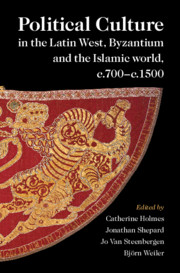 Political Culture in the Latin West, Byzantium and the Islamic World, c.700–c.1500
Political Culture in the Latin West, Byzantium and the Islamic World, c.700–c.1500 Conquest, Migration and Accommodating Diversity
from Part II - Historical Contexts
Published online by Cambridge University Press: 11 August 2021
This chapter provides a brief overview of the political history of the Islamic world, from the seventh-century Arabian conquests to the formation, during the fifteenth and sixteenth centuries, of the three great early modern Muslim empires: the Ottomans in Asia Minor, the Safavids in Iran and the Mughals in India. Its structure reflects the major political formations and transformations of this period: firstly, the Arabian ‘conquest polity’ which replaced the antique balance between Rome and Iran; then, after the demise of that empire in the mid-tenth century, the tumultuous era of ‘Berber’, Daylami and Turkic leaderships; finally, following the cataclysmic Mongol conquest of the eastern Islamic lands in 1258, the assimilation of these conquerors in the east and the political achievements of Turco-Mongol military strongmen and entrepreneurs in Syria, Egypt, Yemen and Anatolia. It looks at the elites and political structures that shaped and underlay this history and at their interaction with Islam. This had developed into a more fully articulated and stable ideological system, whose continued success lay in the new elites’ capacity to adopt and adapt it to their needs.
To save this book to your Kindle, first ensure [email protected] is added to your Approved Personal Document E-mail List under your Personal Document Settings on the Manage Your Content and Devices page of your Amazon account. Then enter the ‘name’ part of your Kindle email address below. Find out more about saving to your Kindle.
Note you can select to save to either the @free.kindle.com or @kindle.com variations. ‘@free.kindle.com’ emails are free but can only be saved to your device when it is connected to wi-fi. ‘@kindle.com’ emails can be delivered even when you are not connected to wi-fi, but note that service fees apply.
Find out more about the Kindle Personal Document Service.
To save content items to your account, please confirm that you agree to abide by our usage policies. If this is the first time you use this feature, you will be asked to authorise Cambridge Core to connect with your account. Find out more about saving content to Dropbox.
To save content items to your account, please confirm that you agree to abide by our usage policies. If this is the first time you use this feature, you will be asked to authorise Cambridge Core to connect with your account. Find out more about saving content to Google Drive.